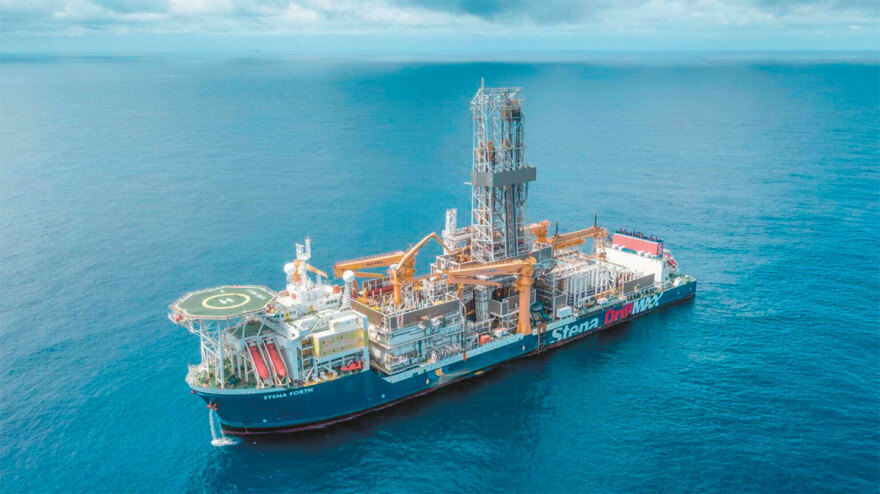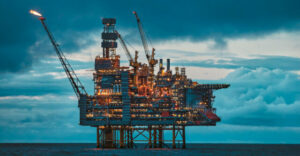A specific part of the “West of Crete” plot, where there are strong indications of a huge oil and/or gas field, is now the focus of the joint venture of ExxonMobil and Helleniq Energy.
The consortium asked for and received an extension to process the 3D data, so news on when the drilling rig will start drilling in the area will be available next April.
The six-month extension requested by the consortium, which has also moved into the second phase of exploration for the other “Southwest Crete” plot, has been formally running since last Thursday.

According to protothema.gr information, from the explorations in both blocks the consortium has strong evidence of a total of three gas fields. As the sources point out, these are two gas fields in the “Southwest Crete” block and one oil field in the “West Crete” block.
Even for the consortium’s ultra-high-tech scientists, what these fields contain is a mystery that will only be solved when the drilling rig goes in. For now, the data that has been acquired indicates that there is a mammoth gas deposit of 30 trillion feet and a smaller, 3.5 trillion-foot mammoth gas deposit in the area.
If confirmed, the first deposit would be the largest in the Mediterranean, surpassing the current largest, “Zor”, in Egypt, and the Israeli “Leviathan” and “Tamar”, which are 29 trillion cubic feet in size. Deposits of this size have the potential to cover the annual needs of the entire Old Continent, and to generate revenues of around €10 billion per year for the Greek State for a century!
In the case of these fields, however, the depths are quite deep, with reports suggesting 3,000-4,500 meters, which is considered normal, as large gas fields are usually found at great depths as well.
When the drills go in
But if these fields are confirmed as exploitable, or even one of them, what happens next? So since interesting targets have been found, which is confirmed by the fact that Exxon has accelerated the process, the drills will start.
Exxon has enlisted the most state-of-the-art equipment on the planet to use on the land it (co-)leases with Helleniq Energy to limit failures in test drilling and make as few (one to three) as possible. This is because each test drilling costs more than €150 million.

This, well-informed sources point out to protothema.gr, is indicative of the importance ExxonMobil attaches to our country, as it is customary – in the absence of hard evidence – not to proceed with test drilling and reject the field. But even if there is reliable evidence, the deposit is rejected if it is less than 30 trillion cubic feet. This may lead us to some conclusion, as does the fact that the Americans accelerated the 2D and 3D surveys by at least two months and the time of the decision to drill test wells by about ten months.
Back to the process, once the Prime Minister announces the start of exploratory drilling, the first exploratory well will be drilled in 2025, with development of the field (if all goes well) starting in 2027 and full production two years later. These, of course, are the normal timelines for exploiting a field (assuming all is as we hear), though the Americans have surprised us recently by speeding up the process at unprecedented rates.
The investors had requested in a letter on October 3 to the Hellenic Hydrocarbons and Hellenic Hydrocarbons and Energy Resources Management Company to extend the deadline for fulfilling their obligations, which was accepted by the Management Company, with a decision signed by its president Aristophanes Stefatos last Monday.
With the companies that make up the consortium maintaining silence on the issue, well-informed sources tell protothema.gr, the extension is open to many interpretations, although the most basic of these is their intention. It becomes clear that the investors have the intention to proceed with the procedures on the specific plot where they believe that there is a hydrocarbon deposit. Otherwise, the same sources point out, no oil company would spend resources and time on a site from which it has nothing to gain.
The investors were due to inform the Greek government by the end of the year and then announce whether they would continue to operate in the area. ExxonMobil, however, after the completion of the 2D and 3D surveys, given that it is ahead of schedule anyway (especially compared to its experience in previous oil exploration around the world), decided to ask for a time credit to allow the data processing process acquired with the 3D surveys to mature.
In practice, this may lead us to conclude, however obliquely, that the consortium has found a deposit (either oil or gas) that is exploitable and wants to concretize its findings. Due to the huge costs of hiring a floating drilling rig and even more so of drilling (especially at great depths, which is where they are located in the Greek case), with further processing of the data it has recovered it will come up with a specific location where the drilling will take place. In essence, he wants to drill one or two exploratory wells in order to proceed with the exploitation of the deposit.

Fire on oil
As analysts see it, ExxonMobil (which owns 70% of the joint venture with Helleniq Energy) has both the vast experience and expertise and unlimited resources that give it the luxury of deciding for itself not only whether to drill, but also when the time is right to do so, given the turmoil in the wider neighbourhood. The tensions of the previous period in the Middle East have escalated into war. And when that war is expected to involve two of the world’s largest oil producers (Iran and Iraq), patience is a wise choice for investors.
This is because, beyond the security issues that may arise, there is also the “investment logic”. Oil prices, which are crucial to the start and continuation of a drilling operation, are on an upward trend. With Brent prices hovering just below $75 a barrel, the launch of 180 missiles from Iran to Israel has also boosted black gold prices by 7%, with analysts estimating that the psychological $100 mark will be easily surpassed this year.
In the (low-probability) scenario of Iran closing the Strait of Hormuz (through which 21% of the world’s daily oil consumption passes), the narrow passage between Oman and Iran that connects the Persian Gulf to the Gulf of Oman and the Arabian Sea, some analysts estimate that the price of oil will soar to historic highs, reaching up to $300 a barrel.
As for the second block, the “Southwest of Crete” block, the lessees ExxonMobil – Helleniq Energy have informed the EDEYEP that the first phase of the exploration stage has been completed and have submitted their request to start the second phase. This stage will be the decisive one for the final decision to drill the wells, which, albeit unofficially, is expected to be taken at the end of this year.
During the first phase, 2D seismic data was acquired and processed (by specialist marine geophysical data company PGS, which completed the surveys in March 2023) over an area of 3,250 km and geochemical surveys were carried out. PGS completed the work program successfully, while adhering to strict environmental measures such as the “soft-start” protocol and the “exclusion zone”. The final work carried out exceeded the minimum expenditure of €5 million stipulated in the contract and the minimum work program, as a total of 7,789 kilometers of seismic were recovered against the 3,250 minimum required.
Typically, the schedule for the first phase of the surveys ended last Thursday, with the next stage officially starting the following day. The second phase has a three-year duration and involves at least completing the acquisition and processing of 3D seismic data.
The ExxonMobil – Helleniq Energy joint venture has already conducted preliminary 3D geophysical surveys in the area in collaboration with PGS during the first quarter of this year. These surveys involved mapping of the seabed and the more superficial layers of the subsurface. The geophysical data collected is already being interpreted and evaluated.
Also involved in the case is the EDEYEP, which has reportedly been pushing investors – and the government – for a year with escalating intensity to ensure that the procedures move at a speed equal to or even greater than that of Eni for the exploitation of “Zor” in Egypt. The words of EDEYEP’s CEO, Aristofanis Stefatos, regarding the developments are typical: “The decision of the consortium to formally announce the activation of the next phase of exploration in the “Southwest of Crete” plot comes one year after Helleniq Energy’s decision to proceed with the second phase of exploration in the “Ionian” and “Block 10” plots.
The fact that the investors are continuing their exploration work confirms our assessment that the Greek region has potentially significant natural gas reserves that can boost the country’s economic development and enhance the energy security of the wider region. We would like to underline the excellent cooperation with the investors who have already executed a large part of the contractual obligations and the second phase of exploration. Which means that they are moving at a faster pace than the relevant timetable, in full respect of the strict measures for the protection of the environment and marine life.”
Ask me anything
Explore related questions





